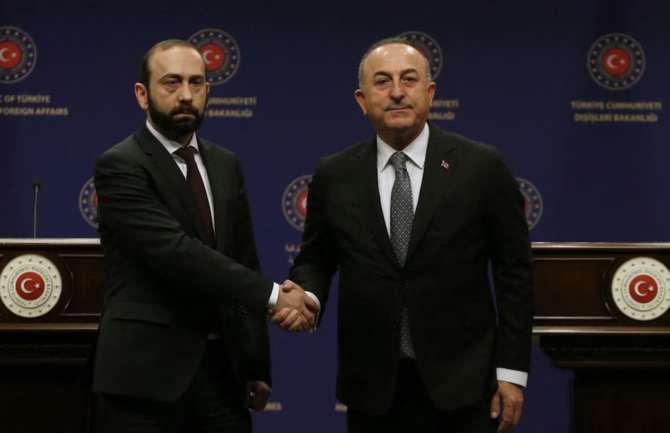Turkiye, Armenia begin to lift physical and mental barriers

https://arab.news/vmn2k
For my two past visits to Armenia, I crossed into the country via the border of a third nation, Georgia, despite the fact that Armenia is one of Turkiye’s immediate neighbors. This was due to the fact that the border between the two countries was closed. While crossing the border, my Armenian colleague emphasized the importance of relations between the two nations and said that, even though there are land borders between countries, minds have no borders. He added: “Two nations can still be close, but before opening the closed border we have to open our mental borders.”
In 1993, during the first Nagorno-Karabakh war, Ankara closed the border and cut relations with Armenia out of support for Azerbaijan, Turkiye’s main ally in the Caucasus. The Turkish-Armenian border remained closed until the aftermath of the devastating earthquake that hit southern Turkiye and northern Syria last month.
The sole land border crossing linking the two countries opened for the first time in more than 30 years to allow Armenian aid and rescuers into the disaster zone. This exceptional opening of the border on Feb. 7 was symbolically very important because the two countries still do not have formal relations, although there is an ongoing normalization process. The same border crossing was also used in 1988, when a big earthquake hit Armenia and the Turkish Red Crescent Society moved aid to the affected areas. As part of the recent earthquake diplomacy, Armenian Foreign Minister Ararat Mirzoyan visited Turkiye to meet with the 27-member Armenian search and rescue team operating in Adiyaman.
However, Turkiye and Armenia now want to go beyond this disaster diplomacy and unlock the border between them permanently. Yerevan announced this week that Turkiye and Armenia plan to allow crossings between the two countries. Mirzoyan said the land border would open only for diplomats and citizens of third countries until the beginning of the tourist season. In early 2023, Turkiye lifted a ban on cargo flights between the two countries.
While both capitals agreed to open the land border, in the meantime there was “football diplomacy 2.0” taking place between Ankara and Yerevan. A UEFA Euro 2024 qualification match between the Armenian and Turkish national teams took place in Yerevan last Saturday. The Turkish sports minister went to Yerevan to attend the match, making him the first Turkish official to visit the Armenian capital in almost two decades.
The two countries want to go beyond disaster diplomacy and unlock the border between them permanently.
Sinem Cengiz
In 2008, ahead of Turkiye’s World Cup qualifier against Armenia, Turkish coach Fatih Terim said: “This is only a football game, it is not a war.” Indeed, it was just a football game, but not an ordinary one.
Back then, it was the first time the two neighboring countries, which have historical animosities toward each other, had come face to face. The Armenian and Turkish presidents visited each other’s capitals to watch the matches played between the two national teams. This move was later described as “football diplomacy,” which served as a bridge between Ankara and Yerevan at that time. This famous football diplomacy paved the way for the signing of the 2009 Zurich Protocols, which were aimed at improving diplomatic relations and reopening the border. However, those protocols were never ratified and they remained as one of the missed opportunities between the two countries.
On Saturday, Armenian football fans gathered at the Republican Stadium, years after the two countries first resorted to football diplomacy, to heal their historical bitterness. Citing security concerns, UEFA had banned Turkish fans from attending the qualifier in Yerevan. The Turkish national anthem was booed by the Armenian fans in the stadium right before the match kicked off. It was a saddening, yet significant, signal, showing that the society is still not ready for normalization, never mind reconciliation.
Normalization and reconciliation are two different processes, which are often confused. While normalization requires the opening of borders and establishment of diplomatic relations between states, reconciliation is a thorough process that requires the establishment of positive relations between two societies. This is tougher than just inking deals at the diplomatic table.
The current phase of normalization between the two countries began with the appointment of special envoys to carry out negotiations, not diplomatic envoys. This itself was a clear indication that normalization will take time. A sincere dialogue based on mutual trust and the necessary confidence-building measures will eventually accelerate the normalization phase, which will be followed by a reconciliation phase. Even if, one day, Turkiye and Armenia do establish diplomatic relations, the tougher task will be the reconciliation of the two nations. While Ankara and Yerevan gradually and reciprocally approach normalization, both leaderships need to pursue successful public diplomacy to consolidate their efforts.
Turkish-Armenian relations are considered to be a “history of missed opportunities.” Both sides should benefit from the ongoing positive climate that has been created, so that history will not repeat itself and the two neighbors can consign their record of missed opportunities to the dusty pages of history.
Although a challenging road lies ahead, a new era appears to be dawning. The change of heart of the two sides could be key to not only unlocking the closed land border, but also the closed mental borders between the two nations.
- Sinem Cengiz is a Turkish political analyst who specializes in Turkiye’s relations with the Middle East. Twitter: @SinemCngz









































